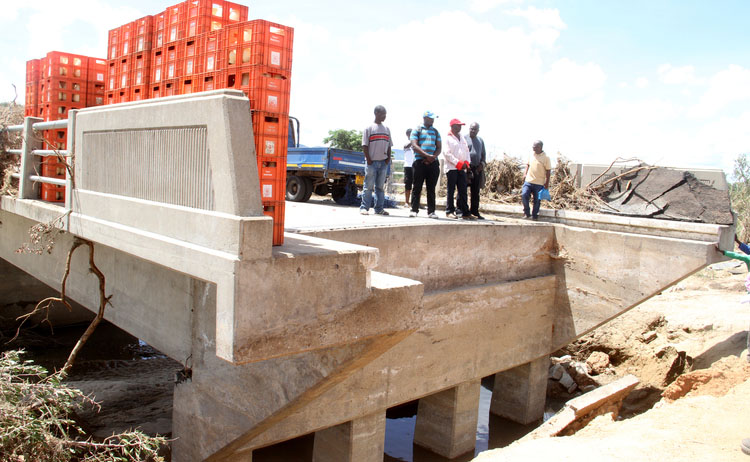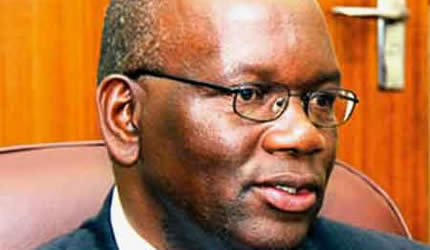Zim motorists under siege


A group of men ponder how to transport crates of opaque beer across Nkankezi River Bridge which was damaged by the rains in Insiza
Herald Reporters
INCESSANT rains pounding Zimbabwe and the region have left a trail of destruction, especially on the country’s road network that needs massive funding for rehabilitation and repairs. Government has already launched an international humanitarian appeal following the floods that have claimed over 246 lives.
A further 128 people were injured, 1 576 marooned while at least 2 000 have been left homeless across the country. The floods have damaged 74 schools while 70 dams have been breached. They have also damaged five health centres.
President Mugabe has declared the floods a state of disaster. Government needs $100 million to repair the roads. The national road network is approximately 17 000km and 71 000km of tarred and gravel roads, respectively. The entire road network has been severely affected by the heavy rains that continue to pound the Southern African region.
In Masvingo, rains have destroyed key infrastructure such as roads, bridges, power lines and homesteads. Small irrigation projects in the province are also under threat after their water reservoirs were destroyed.
Some access roads have been left completely inaccessible. The Chilonga Bridge in Chiredzi and a bridge crossing the Runde River at Chingwizi have been submerged cutting off the southern parts of the district.
This has disconnected communities south of Chiredzi such as Chikombedzi and surrounding areas. Vital access roads linking Chiredzi to surrounding areas have also been cut off due to the flooded Runde River. The incessant rains have affected communities situated close to perennial rivers such as Runde, Tugwi (Tokwe), Shashe and Mutirikwi among others.
Rivers banks have burst under the weight of the floods. In Low-lying areas including Mwenezi, Chivi, Bikita and Chiredzi, the floods damaged homes and other infrastructure. On occasions, the police sub-aqua unit and the Air Force of Zimbabwe have been called to rescue thousands of marooned villagers. In Shashe and Madyangove areas in Mashava and Chivi respectively, the rains have completely destroyed ripening maize crop after Shashe River burst its banks.
This was after the spilling of the upstream Muzhwi Dam. Villagers downstream of the dam in areas like Denga and Nzviyo lost homesteads, livestock and household property. The provincial Civil Protection Unit headed by provincial administrator Mr Fungai Mbetsa is seized with relocating affected families to higher ground.
Mashonaland West province has not been spared from the vagaries of inclement weather leading to destruction of infrastructure. Strong winds and hailstorms have also caused injuries and in the worst cases death. A toddler was killed in Gache Gache, Kariba District, in one of the storms. The District Development Fund reports that around 30 bridges and culverts were destroyed by the rains across the country.
Tarred roads have also succumbed to the continuous downpours, potholes have increased in numbers and sizes. Given limited resources available to authorities, the norm has been thinly spreading whatever funds are available to cover as many areas as possible.
The ritual is exercised annually with the same results where every rainy season sees roads and bridges being swept away. Mashonaland West province has a 2 700km rural road network of which about 2 000kms are in need of attention while 600kms of those need of urgent attention. The province needs close to $4 million needed to put roads to their optimum usable state and repair all damaged structures.
Some of the bridges destroyed include Piriviri in Makonde district, Ume and Marembera in Kariba district and other smaller structures. Sections of the road to Gache Gache have been significantly damaged rendering it difficult to pass through considering the steep terrain. Damage to key infrastructure has affected school children who have since stopped attending lessons.
Attention to the roads and structures in such areas as the agro-based communities such as Sachuru in Sanyati, Mhondoro, Hurungwe and Makonde where farmers need to take their produce to the market. With the tobacco season set to open this month, farmers are waiting with baited breath for road authorities to move in and ensure that roads are usable.
Small steps in the right direction are worth more than a thousand steps in the wrong direction. Manicaland acting provincial administrator, Mr Edgars Seenza said road authorities in the province were still quantifying the extent of the damage by the rains.
He said authorities would have full details on Monday next week and come up with the required funds for repairs. Mr Seenza said each local authority would come up with a detailed account of their respective road networks.
“Our roads are in a bad shape. This is the worst ever condition over the decades and we have a lot of work to do to bring them back into shape,” he said.
The provincial administrator said the incessant rains have washed away several bridges. He, however, noted that funding would be a major deterrent in rehabilitating the roads.
“We are getting funds from Zinara but they are too little considering the magnitude of the damages done on the roads.
“We also have the problem of some local authorities who are failing to access funding from the roads authority after failing to account for previous disbursements,” he said.
The poor road network has adversely affected economic activities in the province, especially the distribution of inputs under Command Agriculture. Mutare Rural District Council chief executive Mr Shepherd Chinaka said meaningful repairs will only be done when the rains subside.
He said council was, however, attending to critical cases like damaged bridges as road maintenance aided soil erosion. Mutare Mayor, Councillor Tatenda Nhamarare said the city council does not have the funds to repair the roads. He said the city’s road network required complete rehabilitating.
There was, however, little funds due to gross underfunding from the council revenues and Zinara, he said.
“We also have challenges with our equipment which comprises one tipper truck, a front-end loader and a grader to maintain the roads,” he said.
The torrential rains have left a trail of destruction in Matabeleland South destroying key infrastructure in Beitbridge District, especially in the low lying areas along the Limpopo River.
Secondary roads linking major business centres such as Shashe to Beitbridge and Beitbridge to Tshikwalakwala have been extensively damaged. Further, the two major highways leading to Bulawayo and Harare, have become pothole riddled endangering the motoring public. An average of 2 000 private cars and 600 haulage trucks use the two roads.
The Civil Protection Unit has been holding meetings to educate the around 80 000 people living in the rural part of the district on the impeding flooding. Villagers in Chituripasi, Malabe, Tshikwalakwala and Shashe remain at high risk of floods so are villages close to Umzingwane, Shashe, Bubi and Limpopo Rivers.
The bridge linking Beitbridge and Chiredzi across Bubi Riwas was swept away in 2013. The rains have stopped work to repair the bridge. Tourism activities in the Greater Limpopo Trans-frontier Conservation Area, which involves Zimbabwe, South Africa and Mozambique, have been affected.
The heavy rains have also hampered a complete assessment of the damages caused with authorities citing accessibility concerns. A humanitarian disaster is looming in Mberengwa East in the Midlands province. This follows damages to two key bridges, Jeka-Chegato and Mwenezi, along the Mwanezi River.
Additionally, Mwanezi, Chingezi, Zverenje and Tandavari bridges along the Mwanezi River were extensively damaged. A number of power lines were also downed in the area.
Transport and Infrastructure Development Minister Joram Gumbo, the area’s legislator, said 4 000 homesteads and other critical infrastructure were completely destroyed by the floods.
He said rehabilitating Jeka-Chegato and Mwenezi Bridge’s was a major priority for the district. Scores of pupils are reportedly not attending school because of the damaged bridges and flooded rivers. Villagers and patients are also failing to access Mnene District Hospital since the district is cut off from the rest of the country. Chegato High School, the biggest in Mberengwa, has been without power since Cyclone Dineo struck two weeks ago. Pupils and teachers are using candles in hostels while fetching water a nearby river to bath because the boreholes use electricity.
A makeshift bridge has been erected to cross the Mwanezi Bridge for people to access schools and the hospital. The hardest his Mberengwa West has also been cut off and there is no communication to the nine wards. Dr Gumbo said even before the rains, the area had challenges with impassable roads, a situation worsened by the floods. He said repairs to the bridges have already begun. Midlands Provincial Roads Engineer, Mr Stephen Kamutema said their priority is on the two high level bridges affected by floods.
He said close to $500 000 was required to repair the bridges.
“Equipment bridge repairs is already on the ground. We are waiting for the rains to stop so that we start backfilling,” he said.
With indications that the rains are set to continue, there is still a possible risk to infrastructure and lives across the country. A prospect whose effects may only be reduced by taking safety measures.









Comments